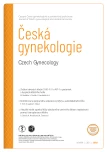Elevated serum concentrations of S100–A11 and AIF-1 in cervical dysplasia patients
Authors:
Maděrka M. 1; Dvořák V. 2; Hambálek J. 1; Stejskal D. 3,4; Krejčí G. 3; Švesták M. 3; Langová K. 5; Pilka R. 1
Authors‘ workplace:
Porodnicko-gynekologická klinika LF UP a FN Olomouc
1; Centrum ambulantní gynekologie a primární péče, Brno
2; Oddělení laboratorní medicíny, AGEL Středomoravská nemocniční, a. s., Prostějov
3; Ústav laboratorní diagnostiky, FN Ostrava 5 Ústav lékařské biofyziky, LF UP v Olomouci
4
Published in:
Ceska Gynekol 2021; 86(1): 11-15
Category:
Original Article
doi:
https://doi.org/10.48095/cccg202111
Overview
Objective: The aim of this study was to compare TFF3, AIF-1, S100–A11 and DKK1 serum levels in patients with cervical dysplasia, and in healthy female controls.
Methods: The first group included 59 patients with a histological diagnosis of precancerous disease CIN 1. The second group included 198 patients with a histological diagnosis of precancerous disease CIN 2 or CIN 3. The control group was comprised of 90 patients who underwent elective total hysterectomy for nonmalignant disorders. In all patients, preoperative serum samples were taken and separated; the sera were all stored at -80°C until the analysis for TFF3, AIF-1, S100–A11 and DKK1.
Results: The serum levels of S100–A11 (P < 0.0001) and AIF-1 (P < 0.0001) were statistically significantly higher in patients with mild precancerous lesions (CIN 1) than in controls. The levels of TFF3 and DKK1 were not statistically significantly different in patients with CIN 1 and in the control group. The serum levels of S100–A11 (P < 0.0001) and AIF-1 (P < 0.0001) were statistically significantly higher in patients with severe precancerous lesions (CIN 2/3) than in controls. TFF3 and DKK1 levels were not statistically significantly different in patients with CIN 2/3 compared to controls.
Conclusion: S100–A11 and AIF-1 represent potential biomarkers in patients with cervical dysplasia.
Keywords:
oncogynecology – cervical dysplasia – biomarkers – precancerous cerviw – S100–A11 – TFF-3 – AIF-1 – DKK1
Sources
1. Cibula D, Petruželka L et al. Onkogynekologie. Praha: Grada Publishing, a. s., 2009 : 616.
2. Thim L, Wöldike HF, Nielsen PF et al. Characterization of human and rat intestinal trefoil factor produced in yeast. Biochemistry 1995; 34 (14): 4757–4764. doi: 10.1021/bi00014a 033.
3. Lau WH, Pandey V, Kong X et al. Trefoil factor-3 stimulates de novo angiogenesis in mam - mary carcinoma both directly and indirectly via IL-8/CXCR2. PLoS One 2015; 10 (11): e0141947. doi: 10.1371/journal.pone.0141 947.
4. Neubert D, Ondrová D, Hambálek J et al. Elevated levels of TFF3 in endometrial cancer patients. Ceska Gynekol 2018; 83 (2): 109–114.
5. Meyerhardt JA, Mangu PB, Flynn PJ et al. Follow-up care, surveillance protocol, and secondary prevention measures for survivors of colorectal cancer: American Society of Clinical Oncology clinical practice guideline endorsement. J Clin Oncol 2013; 31 (35): 4465–4470. doi: 10.1200/JCO.2013.50.7442.
6. Ducreux M, Cuhna AS, Caramella C et al. ESMO Guidelines Committee. Cancer of the pancreas: ESMO Clinical Practice Guidelines for diagnosis, treatment and follow-up. Ann Oncol 2015; 26 (Suppl 5): v56–v68. doi: 10.1093/annonc/mdv295.
7. Molina R, Marrades RM, Augé JM et al. Assessment of a combined panel of six serum tumor markers for lung cancer. Am J Respir Crit Care Med 2016; 193 (4): 427–437. doi: 10.1164/rccm.201404-0603OC.
8. Maděrka M, Pilka R, Neubert D et al. New serum tumor markers S100, TFF3 and AIF-1 and their possible use in oncogynecology. Ceska Gynekol 2019; 84 (4): 303–308.
9. Niehrs C. Function and biological roles of the Dickkopf family of Wnt modulators. Oncogene 2006; 25 (57): 7469–7481. doi: 10.1038/sj.onc.1210054.
10. Niida A, Hiroko T, Kasai M et al. DKK1, a negative regulator of Wnt signaling, is a target of the beta-catenin/TCF pathway. Oncogene 2004; 23 (52): 8520–8526. doi: 10.1038/sj.onc.1207892.
11. Yamaguchi Y, Morita A, Maeda A et al. Regulation of skin pigmentation and thickness by dickkopf 1 (DKK1). J Investig Dermatol Symp Proc 2009; 14 (1): 73–75. doi: 10.1038/jidsymp.2009.4.
12. Rotter L, Rotterová P, Kinkorová Luňáčková I et al. Dysplasia and cervical cancer: current diag - nostic possibilities. Ceska Gynekol 2014; 79 (4): 314–320.
13. Vogelsang TL, Schmoeckel E, Kuhn C et al. Regulation of LCoR and RIP140 expression in cervical intraepithelial neoplasia and correlation with CIN progression and dedifferentiation. J Cancer Res Clin Oncol 2020; 146 (7): 1847–1855. doi: 10.1007/s00432-020-03178-x.
14. Qiu F, Chen F, Liu D et al. LC-MS/MS-based screening of new protein biomarkers for cervical precancerous lesions and cervical cancer. Nan Fang Yi Ke Da Xue Xue Bao 2019; 39 (1): 13–22. doi: 10.12122/j.issn.1673-4254.2019.01.03.
15. Yang W, Song Y, Lu YL et al. Increased expression of programmed death (PD) -1 and its ligand PD-L1 correlates with impaired cell-mediated immunity in high-risk human papillomavirus-related cervical intraepithelial neoplasia. Immunology 2013; 139 (4): 513–522. doi: 10.1111/imm.12101.
16. Liu P, Xin F, Ma CF. Clinical significance of serum miR-196a in cervical intraepithelial neoplasia and cervical cancer. Genet Mol Res 2015; 14 (4): 17995–18002. doi: 10.4238/2015.December.22.25.
Labels
Paediatric gynaecology Gynaecology and obstetrics Reproduction medicineArticle was published in
Czech Gynaecology

2021 Issue 1
Most read in this issue
- Adverse events of PARP inhibitors
- Combined peripartal pubic symphysis and sacroiliac joint separation
- Aspects of embryo selection and their preparation for the formation of human embryonic stem cells intended for human therapy
- Eating disorders in the ambulance of pediatric and adolescence gynecology
